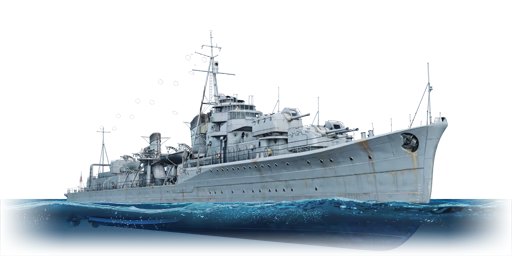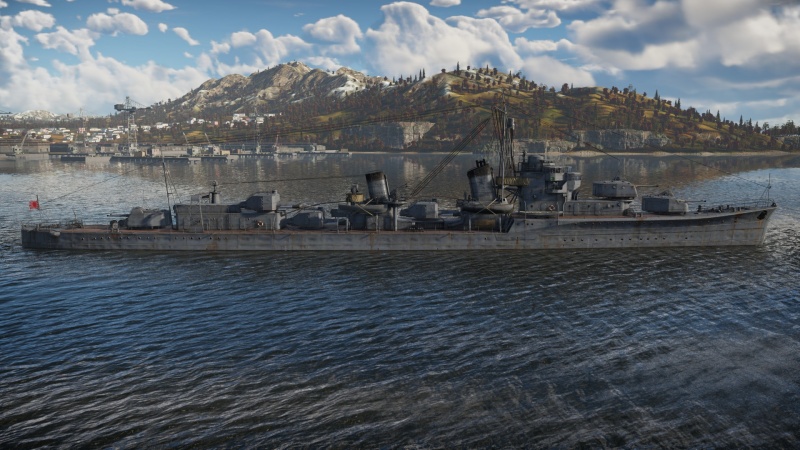Difference between revisions of "IJN Hatsuharu"
Colok76286 (talk | contribs) (Edits) |
(→Description) |
||
| Line 6: | Line 6: | ||
== Description == | == Description == | ||
<!-- ''In the first part of the description, cover the history of the ship's creation and military application. In the second part, tell the reader about using this ship in the game. Add a screenshot: if a beginner player has a hard time remembering vehicles by name, a picture will help them identify the ship in question.'' --> | <!-- ''In the first part of the description, cover the history of the ship's creation and military application. In the second part, tell the reader about using this ship in the game. Add a screenshot: if a beginner player has a hard time remembering vehicles by name, a picture will help them identify the ship in question.'' --> | ||
| − | The '''{{Specs|name}}''' | + | The '''{{Specs|name}}''' (初春, [[Abbreviations#.28JP.29_Naval|namesake]]: Early Spring) was the lead ship of her class, the first Japanese destroyer after the signing of the London Naval Treaty. Due to the displacement restrictions of the treaty, the most recent Japanese Fubuki-class destroyer wasn't allowed to be expanded, so a new design was proposed for future generations of destroyers. However, this didn't deter the Japanese naval design bureau from fitting the same amount of armament on a slightly shorter hull with one less gun, thereby pushing the capabilities of the hull. This resulted in a very top-heavy design, which only came in serious question following the "Tomozuru Incident" of 1934 and the "4th Fleet Incident" of 1935. |
| + | |||
| + | She was introduced in [[Update "Drone Age"]]. Hatsuharu appears in her planned pre-refit configuration, featuring a densely packed and top-heavy structure that makes any hit likely to damage at least one or two critical components. Three 127 mm cannons are mounted on the bow of the ship, providing a higher amount of firepower in a head-on engagement compared to other Japanese destroyers. Additionally, the ship has three triple-mount torpedo launchers squeezed into the center, allowing for the ability to fire 9 torpedoes simultaneously. Though these torpedoes can be reloaded at sea, it poses a risk of an explosive ammo rack if the ship is hit. | ||
== General info == | == General info == | ||
Revision as of 15:01, 9 February 2024
Contents
Description
The Hatsuharu-class, IJN Hatsuharu, 1933 (初春, namesake: Early Spring) was the lead ship of her class, the first Japanese destroyer after the signing of the London Naval Treaty. Due to the displacement restrictions of the treaty, the most recent Japanese Fubuki-class destroyer wasn't allowed to be expanded, so a new design was proposed for future generations of destroyers. However, this didn't deter the Japanese naval design bureau from fitting the same amount of armament on a slightly shorter hull with one less gun, thereby pushing the capabilities of the hull. This resulted in a very top-heavy design, which only came in serious question following the "Tomozuru Incident" of 1934 and the "4th Fleet Incident" of 1935.
She was introduced in Update "Drone Age". Hatsuharu appears in her planned pre-refit configuration, featuring a densely packed and top-heavy structure that makes any hit likely to damage at least one or two critical components. Three 127 mm cannons are mounted on the bow of the ship, providing a higher amount of firepower in a head-on engagement compared to other Japanese destroyers. Additionally, the ship has three triple-mount torpedo launchers squeezed into the center, allowing for the ability to fire 9 torpedoes simultaneously. Though these torpedoes can be reloaded at sea, it poses a risk of an explosive ammo rack if the ship is hit.
General info
Survivability and armour
Talk about the vehicle's armour. Note the most well-defended and most vulnerable zones, e.g. the ammo magazine. Evaluate the composition of components and assemblies responsible for movement and manoeuvrability. Evaluate the survivability of the primary and secondary armaments separately. Don't forget to mention the size of the crew, which plays an important role in fleet mechanics. Save tips on preserving survivability for the "Usage in battles" section. If necessary, use a graphical template to show the most well-protected or most vulnerable points in the armour.
Mobility
Write about the ship's mobility. Evaluate its power and manoeuvrability, rudder rerouting speed, stopping speed at full tilt, with its maximum forward and reverse speed.
| Mobility Characteristics | |||
|---|---|---|---|
| Game Mode | Upgrade Status | Maximum Speed (km/h) | |
| Forward | Reverse | ||
| AB | |||
| Upgraded | 82 | 35 | |
| RB/SB | |||
| Upgraded | 67 | 28 | |
Modifications and economy
Armament
Primary armament
Provide information about the characteristics of the primary armament. Evaluate their efficacy in battle based on their reload speed, ballistics and the capacity of their shells. Add a link to the main article about the weapon: {{main|Weapon name (calibre)}}. Broadly describe the ammunition available for the primary armament, and provide recommendations on how to use it and which ammunition to choose.
| Penetration statistics | |||||||
|---|---|---|---|---|---|---|---|
| Ammunition | Type of warhead |
Penetration @ 0° Angle of Attack (mm) | |||||
| 1,000 m | 2,500 m | 5,000 m | 7,500 m | 10,000 m | 15,000 m | ||
| Type 1 HE | HE | 28 | 28 | 28 | 28 | 28 | 28 |
| HE-TF | HE-TF | 26 | 26 | 26 | 26 | 26 | 26 |
| Shell details | ||||||||||||
|---|---|---|---|---|---|---|---|---|---|---|---|---|
| Ammunition | Type of warhead |
Velocity (m/s) |
Projectile mass (kg) |
Fuse delay (m) |
Fuse sensitivity (mm) |
Explosive mass (TNT equivalent) (kg) |
Ricochet | |||||
| 0% | 50% | 100% | ||||||||||
| Type 1 HE | HE | 910 | 23 | 0 | 0.1 | 2.31 | 79° | 80° | 81° | |||
| HE-TF | HE-TF | 910 | 23 | 0 | 0.1 | 2.07 | 79° | 80° | 81° | |||
Secondary armament
Some ships are fitted with weapons of various calibres. Secondary armaments are defined as weapons chosen with the control Select secondary weapon. Evaluate the secondary armaments and give advice on how to use them. Describe the ammunition available for the secondary armament. Provide recommendations on how to use them and which ammunition to choose. Remember that any anti-air armament, even heavy calibre weapons, belong in the next section. If there is no secondary armament, remove this section.
Additional armament
Describe the available additional armaments of the ship: depth charges, mines, torpedoes. Talk about their positions, available ammunition and launch features such as dead zones of torpedoes. If there is no additional armament, remove this section.
Usage in battles
Describe the technique of using this ship, the characteristics of her use in a team and tips on strategy. Abstain from writing an entire guide – don't try to provide a single point of view, but give the reader food for thought. Talk about the most dangerous opponents for this vehicle and provide recommendations on fighting them. If necessary, note the specifics of playing with this vehicle in various modes (AB, RB, SB).
Pros and cons
Summarise and briefly evaluate the vehicle in terms of its characteristics and combat effectiveness. Mark its pros and cons in the bulleted list. Try not to use more than 6 points for each of the characteristics. Avoid using categorical definitions such as "bad", "good" and the like - use substitutions with softer forms such as "inadequate" and "effective".
Pros:
Cons:
History
Describe the history of the creation and combat usage of the ship in more detail than in the introduction. If the historical reference turns out to be too long, take it to a separate article, taking a link to the article about the ship and adding a block "/History" (example: https://wiki.warthunder.com/(Ship-name)/History) and add a link to it here using the main template. Be sure to reference text and sources by using <ref></ref>, as well as adding them at the end of the article with <references />. This section may also include the ship's dev blog entry (if applicable) and the in-game encyclopedia description (under === In-game description ===, also if applicable).
Media
- Skins
See also
- Related development
External links
Paste links to sources and external resources, such as:
- topic on the official game forum;
- other literature.
| Sasebo Naval Arsenal (佐世保海軍工廠) | |
|---|---|
| Destroyers | |
| Mutsuki-class | IJN Mutsuki |
| Hatsuharu-class | IJN Hatsuharu |
| Shiratsuyu-class | IJN Yuudachi |
| Light Cruisers | |
| Agano-class | IJN Agano |
| Unique Ships | IJN Yubari |
| Tanks | Chi-Ha Short Gun |
| Japan destroyers | |
|---|---|
| IJN | |
| Momi-class | IJN Momi |
| Mutsuki-class | IJN Mutsuki · IJN Satsuki |
| Fubuki-class | IJN Ayanami |
| Hatsuharu-class | IJN Hatsuharu · IJN Nenohi |
| Shiratsuyu-class | IJN Yuudachi |
| Yugumo-class | IJN Yugumo · IJN Hayanami · IJN Kiyoshimo |
| Shimakaze-class | IJN Shimakaze |
| Akizuki-class | IJN Akizuki · IJN Hatsuzuki |
| JMSDF | |
| Ariake-class* | JDS Yūgure (DD-184) |
| Harukaze-class | JDS Harukaze (DD-101) |
| Murasame-class | JDS Murasame (DD-107) |
| * Modified Fletcher-class destroyers | |





